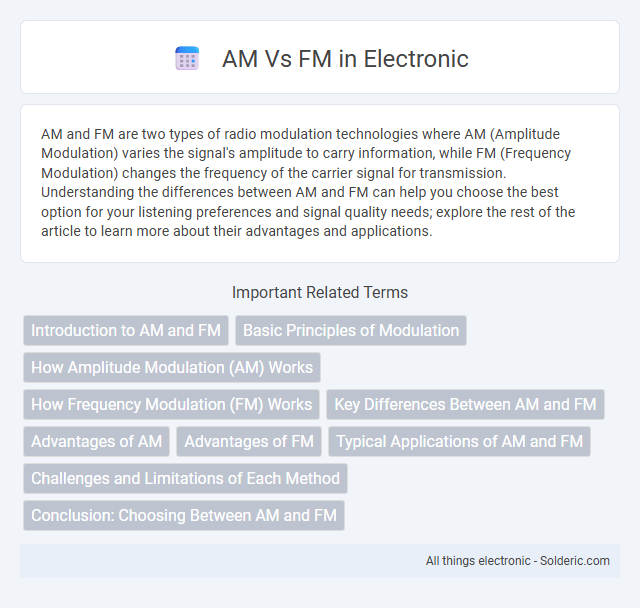AM and FM are two types of radio modulation technologies where AM (Amplitude Modulation) varies the signal's amplitude to carry information, while FM (Frequency Modulation) changes the frequency of the carrier signal for transmission. Understanding the differences between AM and FM can help you choose the best option for your listening preferences and signal quality needs; explore the rest of the article to learn more about their advantages and applications.
Comparison Table
| Feature | AM (Amplitude Modulation) | FM (Frequency Modulation) |
|---|---|---|
| Signal Modulation | Amplitude varies, frequency constant | Frequency varies, amplitude constant |
| Frequency Range | 535 to 1705 kHz (Medium wave) | 88 to 108 MHz |
| Sound Quality | Lower fidelity, prone to static | Higher fidelity, less noise interference |
| Bandwidth | 10 kHz or less | 200 kHz |
| Coverage Distance | Long range, especially at night | Shorter range, better local clarity |
| Interference Susceptibility | High; affected by electrical noise | Low; resistant to electrical interference |
| Typical Usage | Talk radio, news, sports | Music, high-fidelity broadcasts |
Introduction to AM and FM
AM (Amplitude Modulation) and FM (Frequency Modulation) are two primary methods used to transmit radio signals by varying different aspects of the carrier wave. AM modifies the amplitude of the carrier wave to encode audio information, resulting in signals that are more susceptible to noise but capable of long-distance transmission. FM varies the frequency of the carrier wave, providing superior sound quality and resistance to interference, making it ideal for music and high-fidelity broadcasts.
Basic Principles of Modulation
Amplitude Modulation (AM) varies the amplitude of the carrier wave to encode the audio signal, while Frequency Modulation (FM) changes the carrier wave's frequency to transmit information. AM modulation involves shifting the signal amplitude in proportion to the message signal, making it more susceptible to noise interference. FM modulation achieves better noise immunity and higher sound quality by encoding data in frequency variations rather than amplitude.
How Amplitude Modulation (AM) Works
Amplitude Modulation (AM) works by varying the amplitude of a carrier wave in direct proportion to the audio signal being transmitted, while the frequency and phase remain constant. This process encodes the sound information onto the carrier wave, allowing radios to decode and reproduce the original audio. Understanding how AM works helps you appreciate its simplicity and widespread use in broadcasting despite susceptibility to noise and interference.
How Frequency Modulation (FM) Works
Frequency Modulation (FM) works by varying the frequency of the carrier wave in direct proportion to the amplitude of the input audio signal, ensuring the signal's frequency changes encode the sound information. This method reduces noise and interference compared to Amplitude Modulation (AM) because the amplitude remains constant, making FM ideal for high-fidelity broadcasts like music and voice transmissions. The typical FM broadcast band ranges from 88 to 108 MHz, providing clearer reception and improved sound quality over AM's 535 to 1705 kHz range.
Key Differences Between AM and FM
AM (Amplitude Modulation) varies the amplitude of the carrier wave to encode audio signals, while FM (Frequency Modulation) alters the carrier wave frequency. AM is more susceptible to noise and interference due to its amplitude-based transmission, whereas FM provides higher sound quality and better noise resistance by using frequency changes. AM signals can travel longer distances, especially at night, but FM offers superior fidelity ideal for music broadcasting.
Advantages of AM
AM radio offers a longer broadcast range, especially useful for reaching rural or remote areas due to its ability to travel greater distances at lower frequencies. Its simpler signal modulation allows for compatibility with a wide variety of receivers, making it accessible and cost-effective for many users. AM's lower bandwidth consumption enables more channels to be transmitted within a given spectrum, providing ample opportunities for talk radio and news broadcasting.
Advantages of FM
FM radio offers superior sound quality and reduced noise interference compared to AM, making it ideal for music and high-fidelity broadcasts. The use of frequency modulation enhances signal stability over short distances, ensuring clearer reception in urban environments. Your listening experience benefits from FM's ability to deliver consistent audio without static caused by electrical disturbances.
Typical Applications of AM and FM
Amplitude Modulation (AM) is widely used in long-range broadcasting such as AM radio stations, aviation communication, and emergency services due to its simple receiver design and ability to cover vast distances. Frequency Modulation (FM) is preferred for high-fidelity audio broadcasting like FM radio and television sound transmission because of its superior noise resistance and clearer sound quality. FM is also commonly employed in two-way radio systems, including police and fire communication, where signal clarity is crucial.
Challenges and Limitations of Each Method
AM radio faces significant challenges with susceptibility to noise and interference from electrical equipment and atmospheric conditions, which degrades audio quality. FM radio, while providing superior sound clarity and resistance to interference, is limited by a shorter transmission range and line-of-sight restrictions. Understanding these limitations helps you choose the appropriate method based on coverage needs and audio fidelity preferences.
Conclusion: Choosing Between AM and FM
AM radio offers longer range and better signal penetration in remote areas, making it ideal for talk radio and news broadcasts. FM radio provides superior sound quality and reduced interference, preferred for music and higher fidelity programming. Selecting between AM and FM depends on the intended content, listener location, and audio quality requirements.
AM vs FM Infographic

 solderic.com
solderic.com